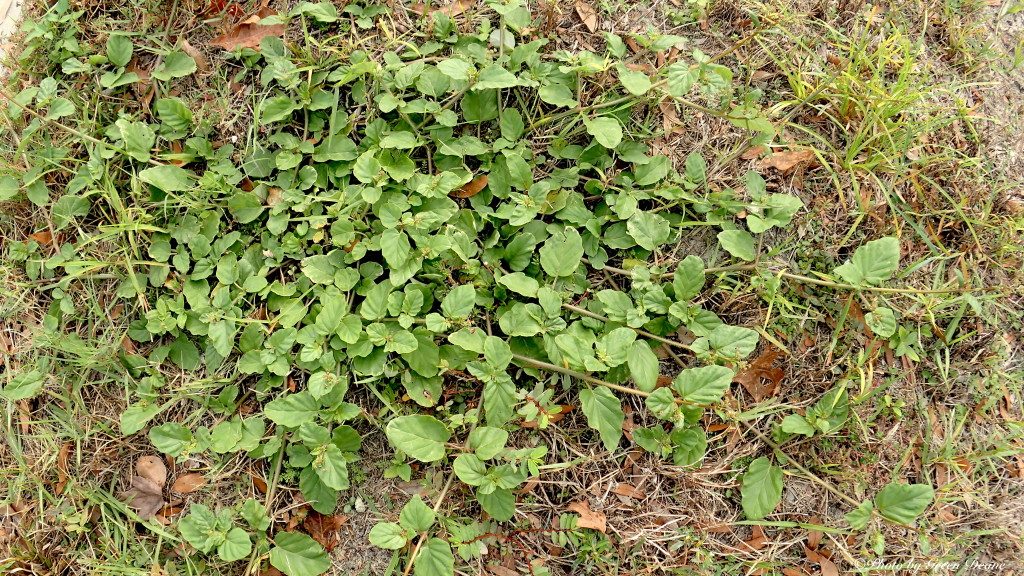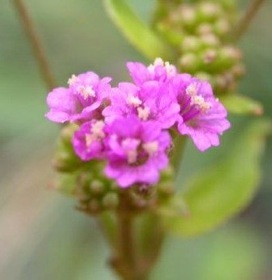Boerhavia diffusa: Catchy Edible
Some times you just can’t identify a plant. Some times you’re frustrated for a few days, other times for a few years. The Tar Vine eluded me for about 15 years.
I will admit to a short attention span, so over those years I would see this particular plant and tell myself to look into it but then I’d see something more interesting. More so, I was born with no patience and have even less now. But that’s off topic, so I’ll get back on track with a short story.
Way back in the mid-90s I knew an unusual fellow named Jose Gotts. I was a member of the local Native Plant Society at the time and went on many excursions with them. Gotts was one of their reigning individuals.
Picture, if you will, an aging roundish man, short, with an Algerian accent and horn-rimmed glasses, rummaging through the woods in Central Florida wearing only shorts. No shoes, no hat, no shirt. That was Dr. Gotts. Yes, doctor. He had a PhD and more in physics but was a botany professor. I never sorted that mystery out. I once asked him about the Boerhavia, though I didn’t know what it was at the time. He told me he had been trying to figure out what that plant was for a long time. He called it Soldier Weed because, he said, it was found everywhere soldiers were. He didn’t know, and I didn’t know, so it was an easy plant to ignore for another day. More than a dozen years later it was brought to my attention by our next Euell Gibbons, Marabou Thomas, a young man on the fast track to greatness. You read that here first.
The problem with Boerhavia diffusa is that locally it rarely grows in wholesome places. One usually sees it eeking out a solar living in sidewalk cracks, or a gnarly rubble pile with trash and garbage. The Boerhavia diffusa is known by the company it keeps. For a plant found on the wrong side of the tracks, it has good side of the track nutrition.
According to a 2008 study championing underused wild edibles it contains saponins, alkaloids and flavonoids. It’s 82.22% moisture, 10.56% carbohydrates, has 44.80 mgs of vitamin C per 100g dry, 97 mg of vitamin B3 and 22 mg of vitamin B2. The mineral content per 100 grams is sodium 162.50 mg, calcium 174.09 mg, magnesium 8.68 mg and Iodine 0.002 mg. Leaf extracts suggests it has possible anti-oxidant activity. It is also medicinal. See the herb blurb below.
And now comes the botanical hanky panky. Whether the Boerhavia is one or two or 40 species is a bit of debate. Some say there are two species, diffusa and erecta, others say no, just one species with variations, others say 16 or even 40. From our point of view the tempest is irrelevant but its other names include: Boerhavia repens var. diffusa (L.) Hook. f., Boerhavia procumbens Banks ex Roxb., Boerhavia repanda Wall., Boerhavia adscendens Willd., Boerhavia paniculata Rich., Boerhavia chinensis (L.) Asch. & Schweinf., and Boerhavia coccinea Mill. When botanists get important they like to change the names of plants, arguing their descriptor is more accurate. All those names translates into, respectfully, the Loosely Spreading Boerhavia, the Upright Boerhavia, the Creeping Boerhavia, the Trailing But Not Rooting Boerhavia, the Boerhavia with leaves with wavy edges, the Ascending Boerhavia, the Boerhavia with flowers in panicles, the Chinese Boerhavia, and the Red Boerhavia. All of them accurate but I don’t seen an outstanding one among them.
As for edibility the young shoots and leaves can be boiled, or made into a sauce. The root is bland, sometimes woody, but it can be roasted. Australian Aborigines ate the root raw but it can make your blood pressure rise and increase urination. The root is carrot like, some think tasting like parsnip, others say it is bland. You remove the tough outer skin before eating. The seeds can be cooked and ground into a powder to be added to other cereals when baking et cetera. The plant itself has good food for cattle and rabbits and has been used to feed pigs in the United States.
In Australia the plant is also home to a caterpillar, Celerio lineata livornicoides, the Tar Vine Caterpillar, called by the Aborigines ayepe-arenye. It’s green with a black line down its back and a spike on the end. The Aborigines would squeeze out the caterpillar’s visera, cook it, then leave it on a rock for a few days before eating it. I note that apparently nothing found it worth stealing in those few days. They also ate new cicadas raw or cooked.
The B. diffusa is called Tar Vine because it can stick to you and other things. In fact, the Aborigines would use it like a net to capture small birds and the like. Its Latin name (for the moment) is Boerhavia diffusa, boar-HAH-vee-ah die-FEW-sa. The species, diffusa, means loosely spreading. The genus was named for Hermann Boerhaave, a polymath of great reputation in his day.
 Boerhaave was a professor, physician, botanist, chemist, philosopher, reluctant clergyman, humanist, and math teacher who lived from 1668 to 1738. He was friends with the great Linnaeus and Voltaire and was a defender of Spinosa. Dutch himself, he knew German, English, Arabic, Hebrew and lectured in Latin. He also started the method of medical learning we now call interning. He was in his day the most famous physician in Europe. In fact one letter mailed to him from China got to him addressed only with: “The Illustrious Boerhaave, physician in Europe.” His home can still be seen. It is Oud Poelgeest Castle now its a hotel but a tulip tree he planted still lives. He was also a sufferer of gout, lumbago, and very allergic to bees. An attack of said when he was a kid left him with an open wound on this thigh for five years. On his death it was rumored that he left a book containing all the secrets of medicine. When it was opened all the pages were blank except one which said “keep the head cool, the feet warm and the bowels open.”
Boerhaave was a professor, physician, botanist, chemist, philosopher, reluctant clergyman, humanist, and math teacher who lived from 1668 to 1738. He was friends with the great Linnaeus and Voltaire and was a defender of Spinosa. Dutch himself, he knew German, English, Arabic, Hebrew and lectured in Latin. He also started the method of medical learning we now call interning. He was in his day the most famous physician in Europe. In fact one letter mailed to him from China got to him addressed only with: “The Illustrious Boerhaave, physician in Europe.” His home can still be seen. It is Oud Poelgeest Castle now its a hotel but a tulip tree he planted still lives. He was also a sufferer of gout, lumbago, and very allergic to bees. An attack of said when he was a kid left him with an open wound on this thigh for five years. On his death it was rumored that he left a book containing all the secrets of medicine. When it was opened all the pages were blank except one which said “keep the head cool, the feet warm and the bowels open.”
Green Deane’s “Itemized” Plant Profile
IDENTIFICATION: Perennial, occasionally an annual, sometimes the base and taproot is woody. Stems loosely spreading, ascending, or erect, usually profusely branched, hairless or barely pubescent, leaves usually on lower half of plant, larger leaves with petiole, broadly lance shaped, or oval, or broadly oval, occasionally round, or wedge shape or even heard shaped, edges wavy, tip obtuse to round, flowers terminal. purplish red to reddish pink or nearly white.
TIME OF YEAR: Year round in warmer areas, summer and fall in temperate areas. Most commonly found in Florida, Georgia, South Carolina, Mexico, West Indies, Central America, South America, Asia, Africa, Indian Ocean Islands, Pacific Islands, and Australia.
ENVIRONMENT: Disturbed areas, waste places, roadsides, dry pine lands, scrub on tropical reefs, sidewalks.
METHOD OF PREPARATION: Young shoots, leaves, boiled. Roots raw or lightly roasted. Take the skin off before eating.




i am facianted by the account of boerhavia (pig weed) i have read. it is wonderful. any way am yet to try any of the suggestion as to its use. thanks
I had a hard time this year ID-ing another from the Nyctaginaceae family, Mirabilis Nyctaginea. It was (sorta) square-stemmed (mint family?), and had big nodes (Polygonaceae?). A book drawing labeled ‘umbrellawort’ finally clued me in. Web info said it’s toxic but pigs like the root, hornworms have been (once?) witnessed chewing the plant, it’s been used medicinally, …, there’s also a related crop, M. Expansa, a formerly lost Inca root crop with potential 2yr yield of 50,000kg/ha (wow?) which is eaten after both(?) sunning and cooking to eliminate an alkaloid mucus-membrane irritant…leaves me wondering if ‘Umbrellawort’ might have similar processing options.
After frying up a few dozen tannin-free acorn grubs, thought other insects might be a way to use plants people can’t eat directly; I can report as one bug’s guinea-pig. ‘Umbrellawort’ turns out to have stem-boring skinny grubs seen behind ‘cobwebs’ inside the stem, and seem to get bigger as they travel down the stems and chew their way out. I ate two, and attribute two symptoms to them. An irritated throat (reminds me of the M. Expansa description) lasted hours; distracting but not overwhelming. A while after noticing that, I also felt uncomfortably hot even though it was a nice cool night. No more experiments on myself with that plant.
Paragraph 1 : ‘eluded’
Paragraph 2: ‘patience’ (unless, of course, you were born a doctor)
Not intended as a critique, nor for public posting on your site – but the proofreader in me just could not resist. It is impossible for one to proofread one’s own work, at least not without the passage of some time, as our brains tend to see what we intended to write, rather than what we did write.
I would like to proofread all the articles on your site for you. They are so informative, and so well written. In a sea of increasingly… casual use of language, even in venerable publications, it is refreshing to find articles that effectively use the written word to both inform and entertain.
Even more, I would enjoy taking a class from you. So, I remain hopeful that you will one day teach a class in New England close enough for me to attend, and at a time of year when I can get away from the farm. Until then-
-Warmest regards.
Thanks… I consider my spelling to be a copyright trap. When people steal my articles including my spelling I have a good argument that they stole said and did not write said. Just as maps have roads that do not exist — to trap copiers — I view my own brand of spelling the same way.
It seems to me this is another case of witnessing a plant in evolutionary flux. They have not yet “established” themselves as clearly defined species so we end up with myriad species, subspecies, & varieties… lumpers and splitters, take your side.
My wife and I were eating raw boerhavia for 5 months daily in salads. It is very tasty! I feel that it is a pity if its boiled. Just to let you know.
I’m interested in buying seeds/seedlings/cuttings of this plant to grow.
I live in San Francisco, CA – and cannot see this plant anywhere.
Not found in SF Arboretum, garden shops, seed shops etc.
Any pointers on where/how i can grow them would be great!
Oh MY GOODNESS! Thank you Thank you. I have been doing battle with this weed for a while. And all the while wondering if it would be on your eat the weeds list. It is quite the prolific (obnoxious) weed. I always love when I find out it’s edible, medicinal uses, like Biden Pelosa. Now I can view this plant in a new and appreciative light.